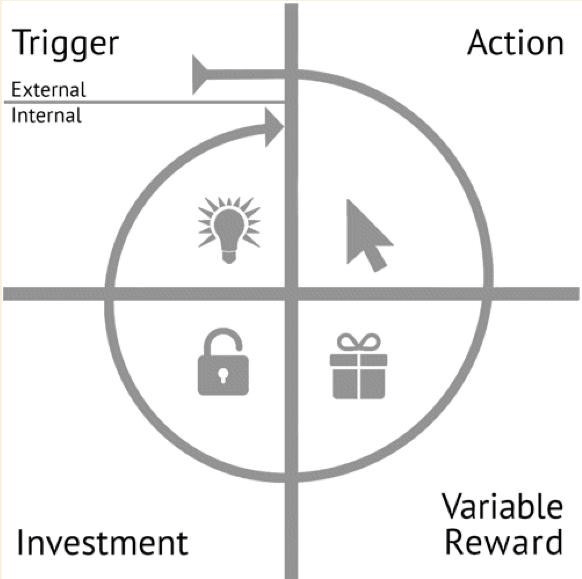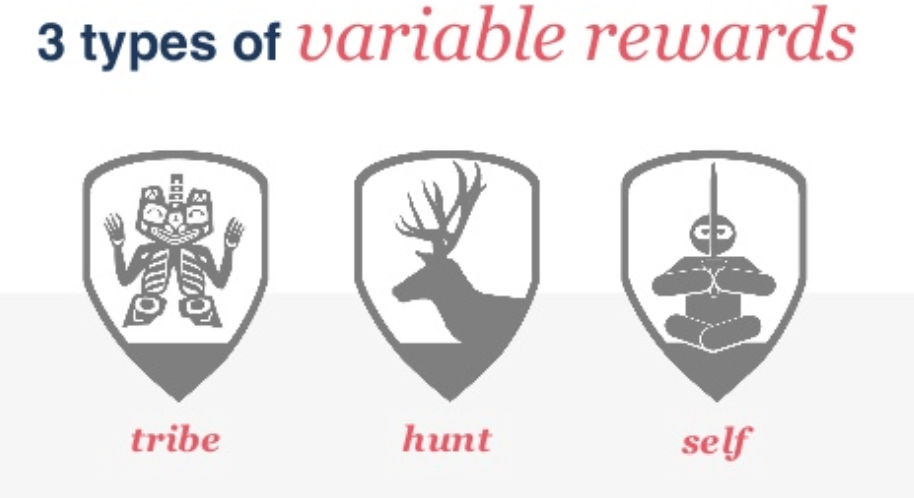I own this book and took these notes to further my own learning. Taking notes, publishing them and re-reading them allow me to flatten my forgetting curve. If you enjoy these notes, I highly encourage you to do the same, buy this book here and take your own notes.
INTRODUCTION
- 79% of smartphone owners check their phone within 15 min of waking up every morning
- People check their phones 34 times a day in 2011…

CORE
- THE HABIT ZONE
- Create a habit is the first/best achievement for a company willing to increase its CLV. W. Buffet: “You can determine the strength of a business over time by the amount of agony they through in raising the price”
- Evernote's Freemium strategy. In the beginning, the usage plummeted. But with time and once habits were created, it ended up to rocket and resulting in curve forming a “smiling shape”. With the usage increasing over time, so did customers’ willingness to pay for the service
- Facebook's success was, in part, a result of “the most important factor to increase growth” (David Skok): the increase of its VIRAL CYCLE TIME. After 20 days with a cycle time of 2 days, you will have 20470 users… but reducing this cycle time by 1, you would have over 20 millions users
- Habits give competition proof, today researches showed that a lot of innovations failed because of consumers’ irrationality to overvalue the old while companies irrationally overvalue the new.
- The enemy of habit creation is past behaviors, and researches found out that old habits die hard. Even when we change our routine, neural pathways remain etched in our brains, ready to be reactivated when we lose focus
- Amazon ads sell cheaper items from other Ecommerce, and it does not hurt the business… on the contrary, Amazon creates the neural habit for users to continue to search for items on the platform to get the best price. Today Amazon becomes a reflex for searching the price of an item
- The habit zone is determined by the Frequency and perceived utility

- “Are you building a vitamin or a painkiller?” is the cliched question many investors ask founders eager to cash their first venture capital check…. But in reality, for most of the habits formed by the tech company, we did not need them at the beginning…
- A habit is when not doing an action causes a bit of pain. By pain, we mean an “itch”, a feeling that manifests within the mind and causes discomfort until it is satisfied.
- TODO: What habits does your business model require? What problem are users turning to your product to solve? How do users currently solve that problem and why does it need a solution? How frequently do you expect users to engage with your product? What user behavior do you want to make into a habit?
- TRIGGER
- Habits are not created, they are built thanks to accumulated layers of actions. The triggers provide the basis for behavior change
- External trigger: paid triggers, earned triggers (features in APP, press mention,…), relationships triggers (referral, word of mouths, like,…), owned triggers (app icon, app notification on users’ phone)
- Internal trigger: when a product becomes tightly coupled with a thought emotion or pre-existing routine, it leverages an internal trigger.
- The product designers’ goal is to find this itch. Users who find a product that alleviates this itch will then create a positive association with the product over time
- Studies showed that people suffering from depression were more likely to consume the internet (videos, emails, gaming…)…
- Finding an internal trigger is more complicated than just asking why a user is using a product… USE 5 WHYs, write strong user narratives
- Instagram: FOMO
- TODO: Who is your product users? What is the user doing right before your intended habit? Find 3 (internal) triggers that could cue your user to action (5whys)? Which internal triggers are the most felt by your users? Write a narrative: “every time a user (trigger), he/she (first action on intended habit)…. Refer back to the question of what is the user doing right before the first action of the habit… FIND the best times and place to send an external trigger. FIND the right external trigger that could be used.
- ACTION
- Action = simplest behavior in anticipation of reward
- What drives an Action? BJ. FOGG => B=MAT (sufficient motivation, ability, trigger)
- Motivation = energy for an action. Motivation is driven by = 1) seek pleasure and avoid pain 2) seek hope and avoid fear 3) seek social acceptance and avoid rejection.
- Hauptly's formula of innovation: understand why a user uses a product, lay out the steps to get the job done, finally reduce the series of tasks from intention to outcome, simply remove steps until you reach the simplest possible process. Evan Williams, the founder of Blogger and Twitter, echoed this formula: “take a human desire (preferably something that has been around for a very long time), use modern technology to take out steps” blogger made posting content easier, twitter's message limitation and constraints increased user's ability to create
- Ability = simplicity is key (Time, money, physical effort, mental effort, social deviance, breaking routine)
- Heuristics to increase motivation and ability: Scarcity effect, Framing effect, Anchoring effect, Endowed Progress Effect,
- To summarize: increased desired behavior with = clear trigger + action as easy as possible + find and align with the right motivator
- TODO: How many steps does it take to your user to get the reward he is looking for? How does it compare with other products, competitors, alternatives… ? Which resources are limiting your users’ ability to accomplish the tasks that will become habits? (Time, Money, effort….). Brainstorm ways to make the task easier. Consider heuristics to make habit-forming actions more likely.
- VARIABLE REWARD

- The reward of the tribe: to feel important, accepted, attractive: like from Facebook, up-vote in StackOverflow
- The reward of the hunt: research for material resources and information: machine gambling, the feed-in Twitter and Pinterest
- The reward of the self: search of intrinsic rewards of mastery, competence, and completion: master the skill in a video game, the mailbox is empty,
- Maintaining a sense of autonomy is very important for repeat engagement: “but you are free to accept or refuse”
- Variability rewards should satisfy users’ need while leaving them wanting to re-engage with the product
- TODO: identify in interviews what users find enjoyable or encouraging about using your product? Are there any moments of delights or surprise? Anything satisfying while using the product? Review the steps a user takes to use your product, what outcome (reward) alleviates the user pain? Is the reward fulfilling, yet leaves the user wanting more? Brainstorm 3 ways your product might heighten users’ search for variable rewards using: rewards of the tribe, the hunt, the self
- INVESTMENT
- Investment is about the anticipation of the reward in the future, investment increase the likelihood of the users to start the hook cycle model again and again
- This investment can be created through several effects: Ikea effect (overvalue what we made) + we seek to be consistent with our past behaviors + we avoid cognitive dissonance
- Twitter investment = following other accounts
- Content + data + skill + reputation … are all form of investment
- By simplifying the investment of sorting, Tinder makes the investment easier
- TODO: review your flow, what bit of work are your users doing to increase their likelihood of returning? Brainstorm 3 ways to add small investments into your product to: load the next trigger, store the value as data, content, followers, reputation, and skill. Identify how long it takes for a loaded trigger to re-engage your users. How can you reduce the delay to shorten cycle time through the Hook?
- NOW, WHAT?
- 5 fundamentals questions of the hook model: 1) What do users really want? What pain is your product relieving (internal trigger)? 2) What brings users to your services (external)? 3) What is the simplest action users take in anticipation of reward? How can you simplify your product to make this action easier (action)? 4) Are users fulfilled by the reward, yet left wanting more? (variable reward) 5) What bit of work do users invest in your product? Does it load the next trigger and store value to improve the product with use?
- Morality, use your own product and believe it can materially improve people's lives to have a higher chance of success
- TODO: challenge the morality of your model, does it influence positive or negative behaviors? How does it make you feel? Are you proud of the way you are influencing the behaviors of others
- HABIT TESTING AND HABIT OPPORTUNITIES
- Steps: 1) dig into data to find how people are behaving and using the product. 2) Generate new hypotheses, study the actions end paths taken by devoted users. 3)Modify the product to influence other people to follow the same path.
- Nascent behaviors = new behaviors that few people see or do and yet ultimately fulfill a mass-market need.
- TODO: Be aware of your behaviors and emotions for the next week as you use everyday products. Ask yourself: What triggered me? Was I prompted internally? Or Externally? Am I using this product as intended? How might these products improve their on-boarding funnels, re-engage users to invest in their service?…